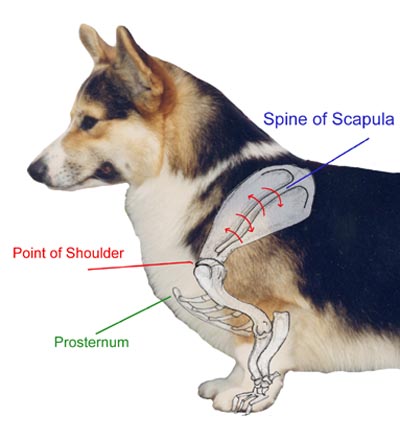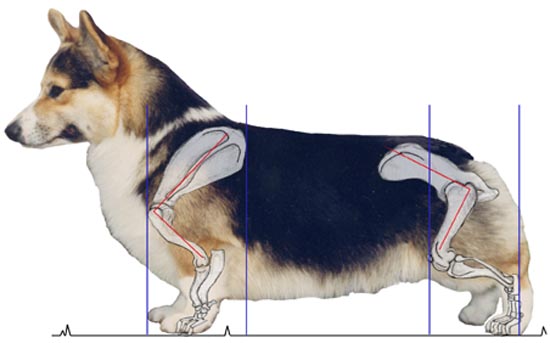 |
Anyway, back to the muscles and ligaments. What most of us think of
first is the term "angulation" when dealing with a front assembly. This is
just a part of it, but does determine how much reach a dog displays. The
upper arm meets the shoulder blade at nearly a right angle. This is easy
to feel if you know where to put your hands. The shoulder blade is a wide, flat bone with a ridge running right down the center. The ridge is there for attachment of the muscles - the longer the shoulder blade the more attachment, the shorter the blade, less attachment. If you put your dog on a table in a show stance with the elbow under the withers and the foot in the proper position (positioning the foot either forward or further back can change the angle of the shoulder blade - lowering or raising the head can throw it off, too) you can easily find the "ridge" along the shoulder blade. I place my fingers along where I think the spine is located and gently move them back and forth as indicated by the arrows to locate the actual ridge. This is a more accurate representation of the actual layback than just "spotting" what you think is the top of the shoulder blade and the point of the shoulder. Once you have determined the line of the ridge, you can see exactly whether the blade is well laid back (pointing further toward the back of the dog) or more upright (pointing more at the sky than at the dog's tail). Next, placing your fingers at the point of the shoulder, you can actually feel the joint where the shoulder blade meets the upper arm. What we see as the point of the shoulder is actually the outside "bump" of the end of the humerus or upper arm, with the inside "bump" the ball part of the ball and socket joint of the shoulder blade/upper arm junction. It is easy to see why the dwarf PWC standard calls for an upper arm *nearly* as long as the shoulder blade - for most breeds the upper arm is longer than the shoulder blade - so the dwarf dog's upper arm can't be longer, but should be nearly the same length. To give the concept a concrete picture in your mind - let's go back to that ridge on the shoulder blade again. If you drew a line that extended that ridge of the shoulder blade on out in front of the dog to the ground, you would have a pretty good idea how much front reach that dog would be expected to have. |
 |
A lot of the overall length in a Pembroke comes from the breadth of the front and rear angulation, not from the ribcage. That combined with the shorter legs, makes the dog look even longer. A dog with upright shoulders and straight stifles may have the same length of back as a better angled dog, but will look much shorter overall. A dog with a shortened front reach will also have some bounce over the withers due to pounding - the front leg is literally pounded into the ground by the rear drive of the dog. A dog with lessened rear angulation will not produce as much pounding or bounce because they are more in balance (there's that word again!) |